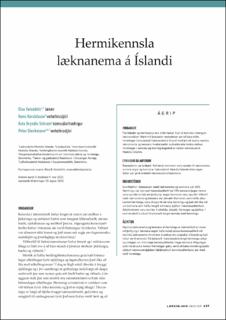| dc.contributor.author | Valsdottir, Elsa | |
| dc.contributor.author | Haraldsson, Hans | |
| dc.contributor.author | Schram, Asta Bryndís | |
| dc.contributor.author | Dieckmann, Gerhard Peter | |
| dc.date.accessioned | 2023-12-29T09:45:09Z | |
| dc.date.available | 2023-12-29T09:45:09Z | |
| dc.date.created | 2023-10-26T10:43:17Z | |
| dc.date.issued | 2023 | |
| dc.identifier.citation | Valsdottir, E., Haraldsson, H., Schram, A.B. & Dieckmann, G.P. (2023) Hermikennsla læknanema á Íslandi. Laeknabladid: The icelandic medical journal, 109 (10), 439-445. | en_US |
| dc.identifier.issn | 0023-7213 | |
| dc.identifier.uri | https://hdl.handle.net/11250/3109077 | |
| dc.description.abstract | BACKGROUND: Skills labs and simulation centers have become an integrated part of teaching methods in many medical schools. This study aims to describe the status of simulation in medical education in Iceland by examining student and faculty experience, facilitating and barring factors for its use in teaching and how the concept appears in the Course Catalog.
MATERIALS AND METHODS: The study was threefold. In parts one and two, electronic surveys were sent to students and faculty members at the Faculty of Medicine, University of Iceland. Part three was a key word search in the University´s course catalogue relating to simulation.
RESULTS: Response rate for both student and faculty surveys was 65%. Simulation as a teaching method was reported for 10% of faculty according to students but approximately a third of faculty, according to faculty. Attitudes of students and faculty were positive. Faculty, previously exposed to simulation, were more likely to use simulation, as were those who had received training in educational methods. Main barriers identified were lack of facilities, equipment, funds, and training. Key words related to simulation appeared rarely in the University Course Catalogue.
CONCLUSION: Student and faculty experience with simulation is limited, less than third of faculty claim to have used simulation when teaching medical students. Barring factors in Iceland are similar to what has been reported elsewhere. Lack of words describing simulation in the Course Catalog may raise questions about emphasis on teaching methods or lack thereof. Potential ways to increase the use of simulation could be to improve infrastructure and offer training in diverse educational methods, including simulation, to selected faculty. | en_US |
| dc.language.iso | ice | en_US |
| dc.publisher | The Icelandic Medical Association | en_US |
| dc.rights | Attribution-NonCommercial-NoDerivatives 4.0 Internasjonal | * |
| dc.rights.uri | http://creativecommons.org/licenses/by-nc-nd/4.0/deed.no | * |
| dc.subject | simuleringsbasert opplæring | en_US |
| dc.title | Hermikennsla læknanema á Íslandi | en_US |
| dc.title.alternative | Simulation in medical education in Iceland | en_US |
| dc.type | Peer reviewed | en_US |
| dc.type | Journal article | en_US |
| dc.description.version | publishedVersion | en_US |
| dc.subject.nsi | VDP::Medisinske Fag: 700 | en_US |
| dc.source.pagenumber | 439-445 | en_US |
| dc.source.volume | 109 | en_US |
| dc.source.journal | Laeknabladid: The icelandic medical journal | en_US |
| dc.source.issue | 10 | en_US |
| dc.identifier.doi | 10.17992/lbl.2023.10.761 | |
| dc.identifier.cristin | 2188717 | |
| cristin.ispublished | true | |
| cristin.fulltext | original | |
| cristin.qualitycode | 1 | |

